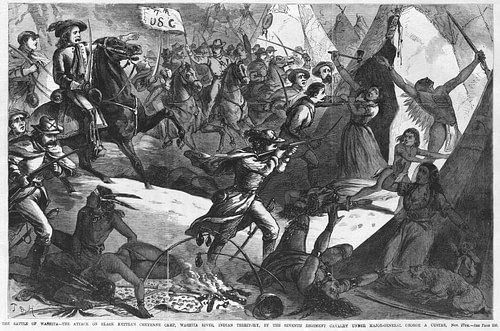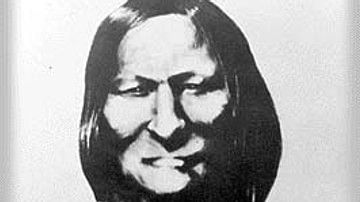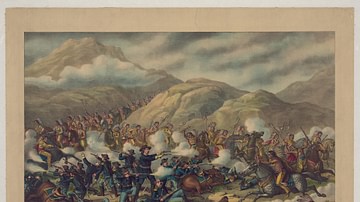My Life on the Plains or Personal Experiences with Indians (1874) is a full-length narrative by George Armstrong Custer (l. 1839-1876) of his time out west from 1867-1874. The work includes his observations on Native Americans and accounts of the military campaigns he participated in, including the Battle of the Washita/Washita Massacre of 27 November 1868.

Custer was under orders from General Philip Sheridan (l. 1831-1888) to wage 'total war' against the 'hostiles' of the Plains Indians who refused to surrender their land and move onto reservations, and this entailed killing warriors in battle, hanging males, capturing women and children to hold as hostages, and destroying villages, horses, ponies, and food supplies. The Southern Cheyenne chief Black Kettle (l. c. 1803-1868) had made it clear he sought peace – and was in no way aligned with any 'hostiles' – since 1851 and had signed every peace treaty presented to the Cheyenne by the US government between that year and 1867.
In November 1868, Black Kettle appealed to US authorities to allow him and his people to move to a position of safety near Fort Cobb where they would not be mistaken for 'hostiles', but his request was denied, and he returned to his village on the Washita River in modern-day Oklahoma near the winter encampments of many other Native American nations. Custer was tracking Native American raiding parties when he found Black Kettle's camp – which was further west and somewhat removed from the other villages.
Assuming this camp to be the home of the raiders he was looking for, Custer attacked at dawn on 27 November 1868, killing between 60 and 150 Cheyenne and Arapaho, mainly women, children, the elderly, and infirm or injured. Custer then took 53 women and children prisoner and returned to his base of operations at Camp Supply. His account established the event as a 'battle' but, by January 1869, after other versions of the event had come to light, it was being referred to as a massacre.
Custer's Account
Custer's initial report to Sheridan claimed he had killed 103 warriors, but, when he and Sheridan returned to the site in December 1868, the body count was considerably higher, and the dead were clearly not all warriors. Most of the Cheyenne men were not in camp that morning as they were out hunting or visiting friends and family in the camps downriver. The men who were in camp defended their homes and families from Custer's attack, most likely in the way he describes below, but, contrary to his claims in his initial report and later, there was no large band of 'hostiles' in the camp, and the raiders he had been tracking probably belonged to one of the villages downstream.
Still, his 1868 report, on which the following account is based, established the event as the Battle of the Washita, and even after that interpretation was challenged in 1869, Custer and his supporters continued to insist he had followed the tracks of raiders to Black Kettle's camp and was obeying orders in attacking a hostile stronghold. Native American survivors of the Washita event described it as a massacre, and a letter written by Captain Frederick Benteen (l. 1834-1898), who commanded troops under Custer at the event, strongly suggests the same.
The version of events that appears in Custer's book presents the engagement as a battle between evenly matched forces, and, as Custer attained legendary status after his death at the Battle of the Little Bighorn in 1876, this version of the event gained greater acceptance, and the 1869 challenges to it were forgotten. These objections to the 'battle' interpretation were revived in the mid-20th century, however, and the debate over whether the Washita River event was a battle or a massacre continues today.

Text
The following account is taken from Custer's My Life on the Plains (1874), pp. 160-164, republished by First Rate Publishers/CreateSpace Independent Publishing Platform in 2014. This is only an excerpt of the much longer account and covers the event from the opening attack on the village through the conclusion of the conflict and rounding up the surviving women and children as prisoners.
At last, faint signs of approaching day were visible and I proceeded to collect the officers, awakening those who slept…All were ordered to get ready to advance; not a word to officer or men was spoken above undertone…In this order we began to descend the slope leading down to the village. The distance to the timber in the valley proved greater than it had appeared to the eye in the darkness of night. We soon reached the outskirts of the herd of ponies. The latter seemed to recognize us as hostile parties and moved quickly away.
The light of day was each minute growing stronger and we feared discovery before we could approach near enough to charge the village. The movement of our horses over the crusted snow produced considerable noise and would doubtless have led to our detection but for the fact that the Indians, if they heard it at all, presumed it was occasioned by their herd of ponies. I would have given much at that moment to know the whereabouts of the first two columns sent out. Had they reached their assigned positions or had unseen and unknown obstacles delayed or misled them? These were questions which could not then be answered. We had now reached the level of the valley and began advancing in line toward the heavy timber in which and close at hand we knew the village was situated.
Immediately in rear of my horse came the band, all mounted and each with his instrument in readiness to begin playing the moment their leader, who rode at their head and who kept his cornet to his lips, should receive the signal. I had previously told him to play "Garry Owen" as the opening piece. We had approached near enough to the village now to plainly catch a view here and there of the tall white lodges as they stood in irregular order among the trees. From the openings at the top of some of them we could perceive faint columns of smoke ascending, the occupants no doubt having kept up their feeble fires during the entire night.
We approached so near the village that, from the dead silence which reigned, I feared the lodges were deserted, the Indians having fled before we advanced. I was about to turn in my saddle and direct the signal for attack to be given, still anxious as to where the other detachments were, when a single rifle shot rang sharp and clear on the far side of the village from where we were. Quickly turning to the band leader, I directed him to give us "Garry Owen." At once the rollicking notes of that familiar marching and fighting air sounded forth through the valley and, in a moment, were reechoed back from the opposite sides by the loud and continued cheers of the men of the other detachments who, true to their orders, were there and in readiness to pounce upon the Indians the moment the attack began.
In this manner, the Battle of the Washita commenced. The bugles sounded the charge and the entire command dashed rapidly into the village. The Indians were caught napping; but realizing at once the dangers of their situation, they. Quickly overcame their first surprise and in an instant seized their rifles, bows, and arrows, and sprang behind the nearest trees, while some leaped into the stream, nearly a waist deep, and, using the bank as a rifle pit, began a vigorous and determined defense. Mingled with the exultant cheers of my men could be heard the defiant war-whoop of the warriors, who from the first fought with a desperation and courage which no race of men could surpass.
Actual possession of the village and its lodges was ours within a few moments after the charge was made, but this was an empty victory unless we could vanquish the late occupants, who were then pouring in a rapid and well-directed fire from their stations behind trees and banks. At the first onset, a considerable number of the Indians rushed from the village in the direction from which Major Elliot's party had attacked. Some broke through the line, while others came in contact with the mounted troopers and were killed or captured.
Before engaging in the fight, orders had been given to prevent the killing of any but the fighting strength of the village but, in a struggle of this character, it is impossible at times to discriminate, particularly when, in a hand-to-hand conflict such as the one the troops were then engaged in, the squaws are as dangerous adversaries as the warriors, while Indian boys between ten and fifteen years of age were found as expert and determined in the use of the pistol and bow and arrow as the older warriors. Of these facts we had numerous illustrations.
[Captain] Benteen, in leading the attack of his squadron through the timber below the village, encountered an Indian boy scarcely fourteen years of age; he was well-mounted and was endeavoring to make his way through the lines. The object these Indians had in attempting this movement we were then ignorant of, but soon learned to our sorrow. This boy rode boldly toward [Benteen], seeming to invite a contest. His youthful bearing, and not being looked upon as a combatant, induced Benteen to endeavor to save him by making peace signs to him and obtaining his surrender, when he could be placed in a position of safety until the battle was terminated; but the young savage desired and would accept no such friendly concessions. He regarded himself as a warrior and the son of a warrior and as such he purported to do a warrior's part.
With revolver in hand, he dashed at [the captain] who still could not regard him as anything but a harmless lad. Levelling his weapon as he rode, he fired, but either from excitement or the changing positions of both parties, his aim was defective, and the shot whistled harmlessly by Benteen's head. Another followed in quick succession but with no better effect. All this time, the dusky little chieftain boldly advanced, to lessen the distance between himself and his adversary. A third bullet was sped on its errand and this time to some purpose, as it passed through the neck of Benteen's horse, close to the shoulder.
Making a final but ineffectual appeal to him to surrender, and seeing him still preparing to fire again, Benteen was forced, in self-defense, to level his revolver and dispatch him, although as he did so it was with admiration for the plucky spirit exhibited by the lad and regret often expressed that no other course under the circumstances was left him. Attached to the saddle bow of the young Indian hung a beautifully wrought pair of small moccasins elaborately ornamented with beads. One of Benteen's troopers afterward secured these and presented them to him. These furnished the link of evidence by which we subsequently ascertained who the young chieftain was [Black Kettle's son], a title which was justly his, both by blood and bearing.
We had gained the center of the village and were in the midst of the lodges, while on all sides could be heard the sharp crack of the Indian rifles and the heavy responses from the carbines of the troopers. After disposing of the smaller and scattering parties of warriors who had attempted a movement down the valley, and in which some were successful, there was but little opportunity left for the successful employment of mounted troops. As the Indians, by this time, had taken cover behind logs and trees and under the banks of the stream which flowed through the center of the village, from which stronghold it was impracticable to dislodge them by the use of mounted men, a large portion of the command was at once ordered to fight on foot, and the men were instructed to take advantage of the trees and other natural means of cover and fight the Indians in their own style.
Cooke's sharpshooters had adopted this method from the first, and with telling effect. Slowly but steadily, the Indians were driven from behind the trees, and those who escaped the carbine bullets posted themselves with their companions who were already firing from the banks. One party of troopers came upon a squaw endeavoring to make her escape, leading by the hand a little white boy, a prisoner in the hands of the Indians, who doubtless had been captured by some of their war parties during a raid upon the settlements. Who or where his parents were, or whether still alive or murdered by the Indians, will never be known, as the squaw, finding herself and prisoner about to be surrounded by the troops and her escape cut off, determined, with savage malignity, that the triumph of the latter should not embrace the rescue of the white boy. Casting her eyes quickly in all directions to convince herself that escape was impossible, she drew from beneath her blanket a huge knife and plunged it into the almost naked body of her captive. The next moment, retributive justice reached her in the shape of a well-directed bullet from one of the trooper's carbines. Before the men could reach them, life was extinct in the bodies of both the squaw and her unknown captive.
The desperation with which the Indians fought may be inferred from the following: Seventeen warriors had posted themselves in a depression in the ground which enabled them to protect their bodies completely from the fire of our men, and it was only when the Indians raised their heads to fire that the troopers could aim with any prospect of success. All efforts to drive the warriors from this point proved abortive and resulted in severe loss to our side. They were only vanquished at last by our men securing positions under cover and picking them off by sharpshooting as they exposed themselves to get a shot at the troopers. Finally, the last one was dispatched in this manner. In a deep ravine near the suburbs of the village, the dead bodies of thirty-eight warriors were reported after the fight terminated.
Many of the squaws and children had very prudently not attempted to leave the village when we attacked it but remained concealed inside their lodges. All these escaped injury, although when surrounded by the din and wild excitement of the fight, and in close proximity to the contending parties, their fears overcame some of them and they gave vent to their despair by singing the death song, a combination of weird-like sounds which were suggestive of anything but musical tones. As soon as we had driven the warriors from the village, and the fighting was pushed to the country outside, I directed Romeo, the interpreter, to go around to all the lodges and assure the squaws and children remaining in them that they would be unharmed and kindly cared for; at the same time he was to assemble them in the large lodges designated for that purpose which were standing near the center of the village. This was quite a delicate mission as it was difficult to convince the squaws and children that they had anything but death to expect at our hands.





